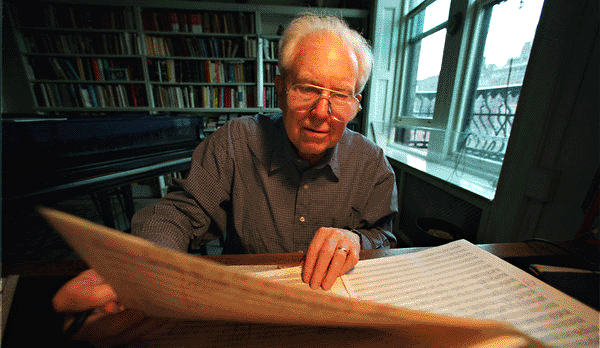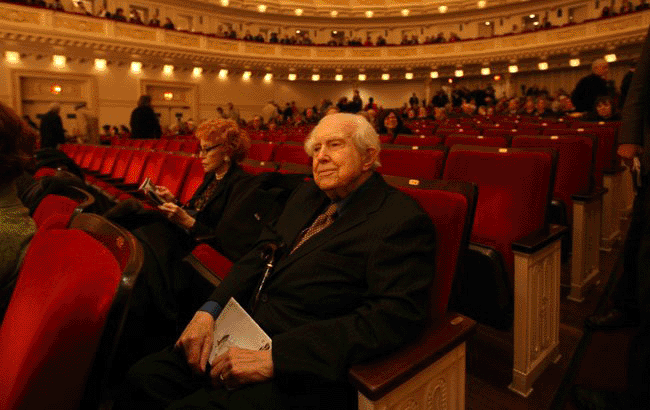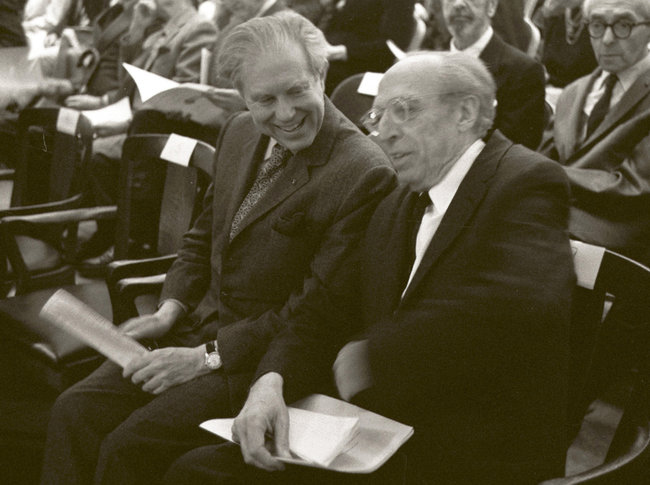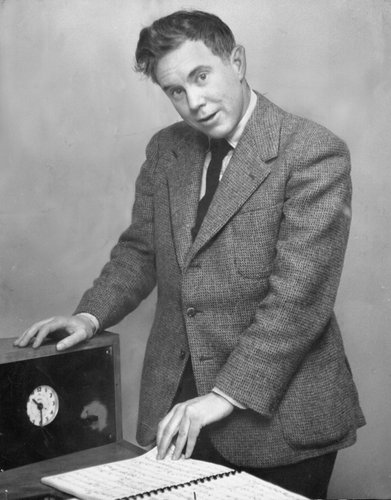
mmm022 Sunday, November 11, 2012
22nd music(ian)'s meeting (November 11, 2012)
Attendees:
tENT
Rob
Ben Opie
Rob arrives & gives tENT Xenakis' Formalized Music bk
Ben arrives & tENT gives him back some recordings & a bk he'd loaned him
Ben shows University of Illinois School of Music record
w/ Krenek, Maderna, Bassett, & Fredrickson music on it
Ben shows Mingus Plays Piano CD
Ben shows "Can You Dig It?
The Music & Politics of Black Action Films 1968-75" 2 CD set
Ben gives CD of soundtrack from Jess Franco's "Vampyros Lesbos"
tENT plays video of beginning of Merce Cunningham's "Suite for Five"
w/ music by John Cage
tENT plays video of Hawkins / Dlugoszewski dance
tENT plays video of Murray Louis' "Antechamber" (1953)
w/ musique concrete from Alwin Nikolais
tENT plays video of the Gian-Carlo Menotti opera for kids called
"Help, Help, the Globolinks!" (w/ electronic music)
w/ costumes & choreography by Alwin Nikolais
tENT plays video of Anna Halprin dances from 1957-1965
including a collaboration w/ Luciano Berio
Rob plays a Ween song for our consideration as to whether it's anti-gay or not
tENT plays video of Tom Lehrer in Oslo from 1963 of him performing his
satirical song "When You're Old & Gray"
tENT shows off the beginnings of his new sound sculpture in his backyard
Rob asks for Grant Green track & Edwin Starr's "Easin' In"
from "Can You Dig It?"
Rob plays his latest hit single "You Got the Part" & "Blow Job"
Here's the mp4 of the highly condensed version of the preceeding:
Ben plays Mingus CD track
tENT plays video of beginning of "Babelization Party" movie from mm 19
tENT plays "J.J.'s Jam" from Steve Lacy's "Anthem"
It's announced that composer Elliott Carter died recently at age 103
(see NY Times obituary below)
Ben leaves
talk about the recent Cage concert
tENT plays Schönberg's "Serenade" at Rob's request
Rob leaves
Elliott Carter, Composer Who Decisively Snapped Tradition, Dies at 103
James Estrin/The New York Times

Elliott Carter, working on a score in his apartment in Greenwich Village in 1996. He won two Pulitzer Prizes.
By ALLAN KOZINN
Published: November 5, 2012
Elliott Carter, the American composer whose kaleidoscopic, rigorously organized works established him as one of the most important and enduring voices in contemporary music, died on Monday in Manhattan. He was 103 and had continued to compose into his 11th decade, completing his last piece in August.
Related
An Appraisal: Elliott Carter, Master of Complexity (November 7, 2012)
In Carter's Music, Look for the Plot (October 27, 1991)

Elliott Carter at a concert celebrating his 100th birthday at Carnegie Hall in 2008.
Neal Boenzi/The New York Times

Mr. Carter with Aaron Copland, right, in 1981.
Richard Termine for The New York Times

Mr. Carter with James Levine, applauding, in 2006.
Fred Plaut/Columbia Records

Mr. Carter in the mid-1950s. His work was considered difficult.
His death was announced by Virgil Blackwell, his personal assistant. Mr. Carter died in his Greenwich Village apartment, which he and his wife bought in 1945 and where he had lived ever since.
Mr. Carter's music, which brought him dozens of awards, including two Pulitzer Prizes, could seem harmonically brash and melodically sharp-edged on the first hearing, but it often yielded drama and lyricism on better acquaintance. And though complexity and structural logic were hallmarks of his works, the music he composed in the decade leading up to his widely celebrated centenary, in 2008, was often more lyrical, if not necessarily softer at the edges.
Mr. Carter, a protégé of the American modernist Charles Ives, acknowledged that his works could seem incomprehensible to listeners who were not grounded in the developments of 20th-century music. Even trained musicians sometimes regarded his constructions as too difficult to grasp without intensive study. Yet he had many advocates among players, and his works were frequently performed and recorded.
"As a young man, I harbored the populist idea of writing for the public," he once explained to an interviewer who asked him why he had chosen to write such difficult music. "I learned that the public didn't care. So I decided to write for myself. Since then, people have gotten interested."
Mr. Carter never lacked for commissions from major orchestras, soloists and chamber groups, and late in life he was able to impose conditions on those who sought his works. He refused to be held to deadlines, saying he would release his compositions when he felt they were ready. And for many years he would not accept commissions from orchestras that had not played his earlier music.
Long before he began enforcing that rule, however, many of Mr. Carter's works had found their way into the active repertory. In the mid-1980s, he observed that hardly a year went by without at least one New York performance of his Double Concerto for Harpsichord and Piano With Two Chamber Orchestras (1961). His Cello Sonata (1948) is considered one of this century's finest additions to that instrument's repertory, and his solo keyboard works, the Piano Sonata (1946) and "Night Fantasies" (1980), are performed regularly and have been recorded several times.
Mr. Carter continued to explore new ground into his later years. He avoided opera for most of his career because, as he put it in 1978, "American opera is a novelty, to be played once and that's all, even when they're good pieces," and because he doubted he could find a libretto that interested him. Yet when he was 90 he completed his first opera, "What Next?"
The opera, with a Dadaistic libretto by Paul Griffiths, a former music critic for The New York Times, had its premiere in 1999 at the Berlin Staatsoper Unter den Linden, with Daniel Barenboim conducting. It had its American premiere in a concert version at Symphony Center in Chicago in 2000 and its first staged performance in the United States at Tanglewood in 2006 - an event filmed and released on DVD.
As Mr. Carter's centenary neared, the frequency with which his music could be heard only increased, making it clear that for at least two generations of young performers, even his thorniest works held little terror. In the summer of 2008, for example, the entire Festival of Contemporary Music at the Tanglewood Music Center was devoted to Mr. Carter's work, with performances of dozens of pieces from every stage of his career (including several premieres). Mr. Carter attended most of the concerts. There were many such tributes that year, and the attention unnerved him, he said.
"It's a little bit frightening, because I'm not used to being appreciated," he said in an onstage interview at Zankel Hall the night after a celebration with the Boston Symphony Orchestra. "So when I am, I think I've made a mistake."
Despite his years, he remained vital almost until the end. His last composition, "12 Short Epigrams," a piano work for Pierre-Laurent Aimard, was completed on Aug. 13. Another piece, "Instances," for Ludovic Morlot and the Seattle Symphony (commissioned with the Tanglewood Music Center), was completed in April.
In June, in what Steve Smith, writing in The Times, called a "miracle of continuing miracles," the New York Philharmonic performed the premiere of "Two Controversies and a Conversation." (Mr. Smith called it a "pocket-size double concerto.")
"The applause for Mr. Carter, wheelchair bound but characteristically animated," Mr. Smith wrote, "resounded thunderously."
Elliott Cook Carter Jr. was born in Manhattan on Dec. 11, 1908, the son of a wealthy lace importer. While he was a student at the Horace Mann School, he wrote an admiring letter to Ives, a New Englander with a crusty manner who nevertheless responded and urged him to pursue his interest in music. When Mr. Carter attended Harvard, starting in 1927, Ives took him under his wing and made sure he went to the Boston Symphony Orchestra concerts conducted by Serge Koussevitzky, who programmed contemporary works frequently.
At Harvard, Mr. Carter completed a bachelor's degree in English before deciding to study composition seriously. He studied with a group of celebrated teachers, including Walter Piston, Edward Burlingame Hill and Gustav Holst. He also received advice from Ives, although their friendship cooled after Mr. Carter made the mistake of showing Ives some compositions he had written in a neo-Classical style.
In 1932, after completing his master's degree, Mr. Carter went to Paris for three years of study with Nadia Boulanger, both privately and at the École Normale de Musique. While in Paris in 1933, he was commissioned to write incidental music for a production of Sophocles' "Philoctetes" at the Harvard Classical Club. The work was his first to be performed in public.
Mr. Carter returned to the United States in 1935, settling first in Cambridge, Mass., and then in New York City, where he began writing criticism for the influential journal Modern Music. In 1937 he began a two-year term as music director of Lincoln Kirstein's Ballet Caravan, for which he wrote the ballet "Pocahontas" (1939), a work with echoes of Stravinsky's "Rite of Spring" and the residue of an early interest in the music of the Elizabethan virginalists.
He also wrote incidental music for Orson Welles's Mercury Theater. A choral work, "To Music," won a 1938 contest sponsored by the Federal Music Project of the Works Progress Administration.
In 1939 he married Helen Frost-Jones, a sculptor and art critic. She died in 2003. Their son, David, survives Mr. Carter, as does a grandson.
Mr. Carter's works of this early period are in neo-Classical and neo-Romantic styles, their modernism kept in check because, as he later explained, the acidic experiments of the avant-garde seemed wrong for a world that was gripped by the Depression. Trying to write music that would appeal to a wide public, he composed an amusing setting of "The Siege of Corinth" (1941), to a Rabelais text, and his First Symphony (1942), an essay in a melodic, almost pastoral style.
By the mid-1940s Mr. Carter had won several prizes but had made little headway with the public, and he began to regard his consonant style as an unrewarding compromise. In the Piano Sonata (1946) and the Woodwind Quintet (1948), he began writing with a sharper edge, and in the Cello Sonata he started the investigation of contrasting materials that remained a fascination. In this case the contrast was between a freely flowing, lyrical cello line and a disciplined, almost marchlike piano part.
Desert Interlude
The turning point in Mr. Carter's style came in 1950, when a Guggenheim Fellowship and a grant from the National Institute of Arts and Letters allowed him to leave a teaching post at Columbia University and spend a year in southern Arizona, outside Tucson. During that year in the Sonora Desert he wrote a single 45-minute work, his First String Quartet.
Recalling his desert sojourn, Mr. Carter said in a 1960 interview: "I had been waiting for just such an opportunity to give form to a number of novel ideas I had had over the previous years, and to work out in an extended composition the character, expression and logic these ideas seemed to demand. I felt that I was constantly pushing into an unexplored musical realm."
Internal Oppositions
What he came up with was a process he called "metrical modulation." Each instrument has a distinct personality and moves at an independent rhythm. The effect is of a constant change of tempos. Thereafter, virtually all of Mr. Carter's works were driven by the tension between independent and starkly contrasting elements.
In the Second String Quartet (1959), for example, each instrument is given its own distinct vocabulary of intervals and rhythms. In the Double Concerto of 1961, the piano and harpsichord, each allied to its own chamber orchestra, speak in languages appropriate to their timbres. In the first half of the work, the opposing groups move toward consensus; in the second, they split apart.
Between the 1950s and the late 1970s, Mr. Carter typically spent several years on each new work and saw every piece as an opportunity to overcome new challenges, some purely musical and others narrative and dramatic.
"I just can't bring myself to do something that someone else has done before," he said in 1960. "Each piece is a kind of crisis in my life."
Starting in the late 1980s Mr. Carter's production picked up speed, and by 2005 he was routinely producing streams of works, albeit short ones, every year, sometimes at the request of musicians who admired his work and sometimes spontaneously for musicians he admired.
When asked why his early works took so long to complete, Mr. Carter explained that his method of composing dictated his speed. "I like to sound spontaneous and fresh, but my first sketches often sound mechanical," he said. " I have to write them over until they sound spontaneous." Many of his scores were completed only after he had filled thousands of pages with sketches. He meticulously dated and saved these, an idea he said he got from Igor Stravinsky. Mr. Carter intensified his use of contrasting forces in works like the Third String Quartet (1971) and the Symphony of Three Orchestras (1977). In these compositions the main ensemble is divided into subgroups, each of which is given a distinct set of movements. The movements are played simultaneously with those performed by competing groups. But they are not played in a conventional way, from start to finish. Instead, the players may be asked to play part of a first movement, all of a second and part of a third before returning to where they left off in the first.
In works like "Syringa" (1978), a vocal setting of the poet John Ashbery's updated version of the Orpheus legend, the internal oppositions are set forth more clearly. As a mezzo-soprano offers an understated account of the Ashbery text, a bass vehemently sings fragments of Greek classical texts.
"I regard my scores as scenarios," Mr. Carter said in 1970, "for the performers to act out with their instruments, dramatizing the players as individuals and as participants in the ensemble."
That interest remained with him. His String Quartet No. 5 (1995), for example, conveys his fascination with a quartet's rehearsal methods, including the debates between players about phrasing and coloration. The work is in 12 connected movements, five of which are interludes that describe the discussions, with one player offering a phrase from the section just heard and the others responding with embellishments, humorous turns or consternation.
Some listeners found his music cerebral, elitist and devoid of emotion. Even some who respected Mr. Carter's erudition and the detail inherent in his compositional method were unmoved by his music.
Reviewing the Concerto for Orchestra (1969) when Leonard Bernstein led the New York Philharmonic in the work's world premiere, Harold C. Schonberg wrote in The Times, "It may be a tour de force of its kind, but to me it is essentially uncommunicative, dry and a triumph of technique over spirit."
In the mid-1970s, Mr. Carter's music began to return to forms that he had not addressed since the 1940s.
With "A Mirror on Which to Dwell" (1975) and "Syringa," he began reconsidering the voice, and he continued his exploration in "In Sleep, in Thunder" (1981) and "Of Challenge and of Love" (1994), vocal chamber works that in retrospect seemed steps on Mr. Carter's path to opera.
Around the same time, "Night Fantasies" (1980), an evocative description of the fleeting states of thought one experiences between sleep and wakefulness, was the first in a stream of solo instrumental pieces for guitar, violin, trombone, flute, harp, clarinet, cello and piano. He also composed a series of concertos for various instruments, including oboe, violin and clarinet, and a 50-minute orchestral triptych, "Symphonia: Sum Fluxae Pretium Spei." Indeed, Mr. Carter began composing at a brisk pace in the mid-1980s. Instead of spending several years writing a single piece, he was writing a handful of pieces a year.
Moreover, they seemed to reach out to listeners in a way that the earlier works had not. The Oboe Concerto (1987) and the Violin Concerto (1990) were decidedly lyrical, even though Mr. Carter's harmonic language remained essentially dissonant. And in the "Triple Duo," (1983) the dialogues within and between the three independent instrumental groups are slyly witty and even overtly comic.
Two Decades, Two Pulitzers
Mr. Carter taught at several American conservatories and colleges, including the Peabody Conservatory, Queens College, Columbia, Harvard, Yale, Princeton and Cornell and the Juilliard School.
He was awarded Pulitzer Prizes for his Second String Quartet in 1960 and his Third String Quartet in 1973. A recording of his Violin Concerto won a Grammy Award for best contemporary composition in 1994.
Among his many awards was the National Medal of Arts, bestowed in 1985. In September, France awarded him the insignia of Commander of the Legion of Honor. Mr. Carter was elected to the American Academy of Arts and Sciences in 1963 and to the American Academy of Arts and Letters in 1969.
Mr. Carter did not seem bothered by objections to the difficulty of his music, and he expressed confidence that it would eventually be understood.
"There are many kinds of art," he said in 1978, when asked what he had to say to concertgoers who felt that great music should have tunes that could be whistled. "Some kinds are hard to understand for some people, and easy to understand for others. But if the works are very good, then finally a lot of people will understand them. And it seems to me that if a work has something remarkable to say, then someone who wants to whistle it will find something in it to whistle. But these things are very subjective.
"Just this morning, I had a call from Ursula Oppens, who is playing my Piano Concerto. She said, 'I finally know all the tunes in your concerto.' I said, 'Which tunes are those?' And she whistled one. So there you are."
This article has been revised to reflect the following correction:
Correction: November 7, 2012
An obituary on Tuesday about the composer Elliott Carter misstated, in some editions, the given name of the musical director of the Seattle Symphony, for which Mr. Carter composed the piece "Instances" this year. He is Ludovic Morlot, not Pierre Morlot. The obituary also misidentified the venue where the American premiere of Mr. Carter's opera "What Next?" was performed. It was at Symphony Center in Chicago, not at Carnegie Hall. And because of an editing error, the obituary misstated the year that Mr. Carter's wife, the former Helen Frost-Jones, died. It was 2003, not 1998.
to the mm index
forward to mm 23
backward to mm 21
to the tENTATIVELY, a cONVENIENCE movie-making "Press: Criticism, Interviews, Reviews" home-page
to the "tENTATIVELY, a cONVENIENCE - Sprocket Scientist" home-page
to the "FLICKER" home-page for the alternative cinematic experience
to find out more about why the S.P.C.S.M.E.F. (Society for the Prevention of Cruelty to Sea Monkeys by Experimental Filmmakers) is so important
for info on tENTATIVELY, a cONVENIENCE's tape/CD publishing label: WIdémoUTH
to see an underdeveloped site re the N.A.A.M.C.P. (National Association for the Advancement of Multi-Colored Peoples)